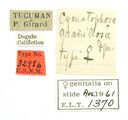Cymatophora
Cymatophora
Classification
- Phylum: Arthropoda
- Subphylum: Hexapoda
- Class: Insecta
- Order: Lepidoptera
- Superfamily: Geometroidea
- Family: Geometridae
- Subfamily: Ennominae
- Tribe: Angeronini
- Genus: Cymatophora
Pronunciation
How to pronounce Cymatophora: //ˌsaɪˈmætəˌfɔːrə//
These audio files are automatically generated. While they are not always 100% accurate, they are a good starting point.
Images






Summary
Cymatophora is a monotypic genus of moths known for its large size and distinct wave-like patterns on its wings, primarily represented by the giant gray moth (Cymatophora approximaria).
Physical Characteristics
Cymatophora approximaria, commonly known as the giant gray moth, exhibits a wingspan that can reach up to 4 inches (10 cm). The coloration is predominantly gray, which offers excellent camouflage against tree bark and other natural surfaces.
Identification Tips
Look for the large size and gray coloration, as well as the distinctive wave-like patterns on the wings that give this moth its name.
Habitat
This moth typically inhabits woodlands, forests, and areas near water in the southeastern United States.
Distribution
Cymatophora approximaria is primarily distributed across the southeastern United States.
Diet
The larvae of Cymatophora approximaria primarily feed on a variety of deciduous trees.
Life Cycle
The life cycle includes egg, larval (caterpillar), pupal, and adult stages, with overwintering occurring in the pupal stage.
Reproduction
Cymatophora approximaria reproduces sexually with females laying eggs on host plants in the spring.
Predators
Natural predators include birds and other insects, particularly during the larval stage.
Ecosystem Role
As both a caterpillar and an adult moth, Cymatophora approximaria contributes to the food web, serving as food for various predators.
Evolution
Cymatophora is a monotypic genus, indicating it has evolved independently from other genera within the Geometridae family since its classification by Hübner.
Similar Taxa
Misconceptions
Due to its large size and gray coloration, it may be confused with other moths in similar habitats, leading to misidentification.
Tags
- Moths
- Lepidoptera
- Geometridae
- Cymatophora
- Giant Gray Moth